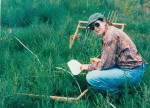Unlike many other ecosystems, the shortgrass steppe has not been invaded by exotic species to any significant degree. Prior research on the SGS-LTER has shown that exotic species are virtually nonexistent in undisturbed shortgrass steppe, but can be found in areas of disturbance and higher resource availability such as roadsides and riparian areas. Prior research has also found that exotic species are more likely to germinate and survive in areas on the shortgrass steppe that are not grazed by domestic cattle. The seeming unique resistance of the shortgrass steppe to invasion by exotic plants has prompted LTER researchers and graduate students to investigate the dynamics of exotic species in this ecosystem.
We asked two questions in an attempt to understand why so few invasives were found in the steppe:
- Is invasion limited by seed availability?
- Is invasion limited by resource (water and nitrogen) availability?
Samples of the soil seed bank indicated that availability of invasive seeds declined exponentially from the roadsides to 25 meters into the steppe suggesting that the presence of invasive species in the steppe is limited by seed dispersal.
Experimental additions of water and nitrogen to plots in which the invasive annual grass Bromus tectorum was seeded indicated that increased availability of water combined with nitrogen had a significant positive effect on survivorship, and that nitrogen alone and in combination with water significantly increased aboveground biomass. Both seed and resource availability are apparently influencing the current success of invasive plants in the shortgrass steppe. Our results suggest that anything that increases the dispersal of invasive propagules into the steppe in combination with increased water and nitrogen availability could result in a plant invasion.
The current disturbance regime occurring in the shortgrass steppe results in a continuous supply of microsites with increased water and nitrogen availability. A substantial plant invasion may only be awaiting the introduction of a species with an effective long distance seed dispersal mechanism.
If increased resource availability causes invasion in shortgrass steppe, can reducing availability reverse this?
Previous research on the shortgrass steppe has found that short-term increases in nitrogen and water availability above what this system normally experiences leads to a dramatic, long-term shift from native steppe to a community dominated by exotic, invasive annuals.
Additional research found that the exotic plants sequestered more nitrogen in their aboveground tissue, and it was hypothesized that the community change persisted through time due to a plant tissue/soil organic matter feedback mechanism. If increased resource availability encouraged the dominance of the exotics, could reducing availability decrease exotic species? We tested the hypothesis that adding carbon amendments in the form of humus precursors and sucrose would indirectly reduce the prevalence of exotic species, and increase native species, by decreasing plant available nitrogen on short-term and long-term time scales.
We superimposed six new carbon treatments, control, sugar, lignin, sawdust, lignin and sugar, and sawdust and sugar, on a historic study site that received nitrogen, water, or the combination from 1970-1975, resulting in a dramatic increase in exotic species on the water plus nitrogen amended plots, a community change that persists into today.
All of the new carbon treatments significantly reduced exotic species richness and aboveground biomass compared to the controls, regardless of the historic treatment. The new carbon treatments, with the exception of lignin alone, reduced exotic species density by an average of 50% on the historic water plus nitrogen plots. Our results show that the addition of carbon amendments can reduce exotic species density on the shortgrass steppe, at least over short time scales.
Future research
Although very few exotic species have been found in undisturbed shortgrass steppe in the past, recently patches of one exotic species, Linaria dalmatica (dalmatian toadflax), have been discovered growing in pastures on the SGS-LTER. It is unknown how the plants arrived at their current location, but it is known that the patches are expanding.
A new graduate student is planning on investigating the dynamics of these unusual exotic species patches by mapping the patch boundaries with a GPS unit, counting tillers, and looking at the root development of this potentially invasive species.

 Enlarge this image
Enlarge this image